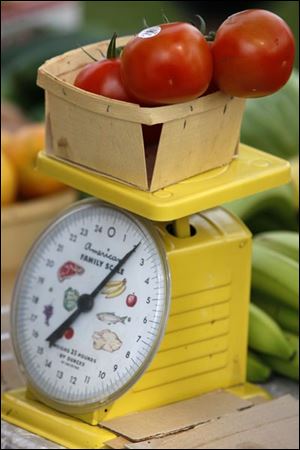
Legislators reap compromise on official Ohio fruit
1/19/2009
The winner of the Statehouse tussle. Many insist on referring to it as a vegetable.
COLUMBUS - In the waning days of the 127th General Assembly, lawmakers and the governor couldn't agree on election reform, bonuses for military veterans, and movie tax credits, but they did agree on one thing.
The tomato won the battle with the pawpaw to be dubbed Ohio's official fruit.
And even that was a compromise among lawmakers as the runner-up became the state's official native fruit.
Gov. Ted Strickland signed it into law, as part of a bill that included designations of "Ronald Reagan Day" and "Ohio Boy Scouts Week"; the renaming of roads and bridges; and creation of an "In God We Trust" license plate.
For Chris Chmiel, co-owner of the Integration Acres pawpaw processor in Albany and one of the founders of the annual Ohio Pawpaw Festival, the tug of war was a lesson in modern democracy.
"We got into this, and as soon as we did the apple people and tomato people got involved," he said.
"So we're not the state fruit. We're the state native fruit. We were a compromise. We didn't have the lobby of the apple or
tomato industries. I learned a lot about politics by having to go up there and testify."
The decision took several years to achieve, longer than is typically required for passage of a two-year state budget or a revamping of the state's energy plan.
Mr. Chmiel figures the little-known banana-like pawpaw, which doesn't ship or keep well, needed the publicity more than did the tomato, which many still insist on calling a vegetable.
Brent Clement, of Yakima, Wash., believes Ohio ultimately made "a wise choice."
He is co-editor of the Tomato Magazine, which targets the tomato-growing industry as well as the average gardener.
"The tomato ranks among the top five of the most popular on the market," he said.
"It's high in a number of nutrients and cancer-preventing agents. It's healthy and nutritious. People feel like something's been left out if they don't have fresh tomatoes, tomato sauce, or tomato paste. It's one of the backbone fruits of the industry.
"Even for home gardeners, if they're limited on space, the tomato will be the fruit of choice," he said.
But even he routinely slips into referring to the tomato as a vegetable.
"Technically, it's a fruit," he said.
"It's as healthy as a vegetable. When I look out into a field of vegetables or see it grown in greenhouses, it's more like a vegetable."
And he doesn't usually think of Ohio when he thinks of tomatoes, despite the tomato's importance as a seasonal industry, particularly in northwest Ohio. Tomato juice has been Ohio's official state beverage since 1965.
"The big players are California and Florida," he said. "That's where most of the production is. Although the New Jersey tomato is also well known."
Ohio is not the first state to lay claim to the tomato.
Tennessee picked the tomato as its state fruit in 2003, and Arkansas was more specific, electing the Vine Ripe Pink Tomato two decades ago. Arkansas played it safe by naming the tomato both the official state fruit and vegetable.
No one else has made claim to the pawpaw, all the more reason that it should have prevailed for top honors, said Mr. Chmiel.
The fruit is indigenous to the continent and thrives in the Mississippi, Missouri, and Ohio river valleys. Looking like a cross between a banana and papaya, the nontropical pawpaw has a custard-like texture when fresh and tastes somewhat like banana or mango.
"It's pretty much an Appalachian type of thing," Mr. Chmiel said. "It's a native fruit, mostly in the southern part of the state. The pawpaw grows north on the lake, but they haven't the quality of fruit that comes from the southern part of the state. It has grown 30,000 years or more. Ninety to 95 percent of people have never heard of them.''
That's largely because, unlike the tomato, the pawpaw is highly perishable. Unless eaten fresh from the tree limb, the pawpaw is likely to be consumed in a processed and frozen version. That's what Mr. Chmiel's family Integration Acres business does.
His favorite way to enjoy pawpaw is in a smoothie.
"God love the tomato, but it's just not as exciting as the pawpaw," he said. "The silver lining that I see in all this is that the pawpaw is Ohio's first state native fruit."
Contact Jim Provance at:
jprovance@theblade.com
or 614-221-0496.